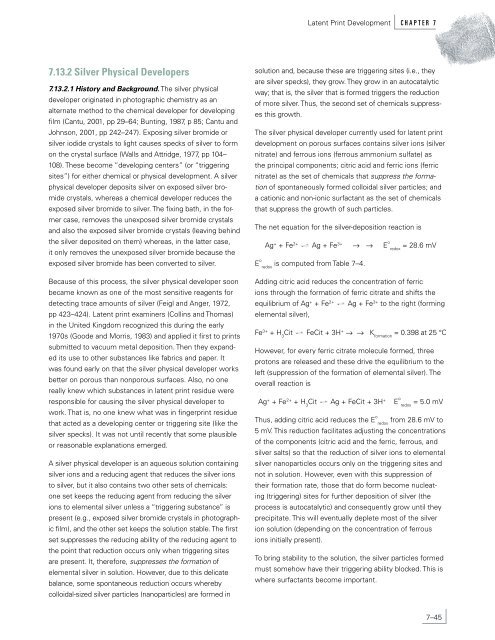Latent Print Development - National Criminal Justice Reference ...
Latent Print Development - National Criminal Justice Reference ...
Latent Print Development - National Criminal Justice Reference ...
You also want an ePaper? Increase the reach of your titles
YUMPU automatically turns print PDFs into web optimized ePapers that Google loves.
7.13.2 Silver Physical Developers<br />
7.13.2.1 History and Background. The silver physical<br />
developer originated in photographic chemistry as an<br />
alternate method to the chemical developer for developing<br />
film (Cantu, 2001, pp 29–64; Bunting, 1987, p 85; Cantu and<br />
Johnson, 2001, pp 242–247). Exposing silver bromide or<br />
silver iodide crystals to light causes specks of silver to form<br />
on the crystal surface (Walls and Attridge, 1977, pp 104–<br />
108). These become “developing centers” (or “triggering<br />
sites”) for either chemical or physical development. A silver<br />
physical developer deposits silver on exposed silver bromide<br />
crystals, whereas a chemical developer reduces the<br />
exposed silver bromide to silver. The fixing bath, in the former<br />
case, removes the unexposed silver bromide crystals<br />
and also the exposed silver bromide crystals (leaving behind<br />
the silver deposited on them) whereas, in the latter case,<br />
it only removes the unexposed silver bromide because the<br />
exposed silver bromide has been converted to silver.<br />
Because of this process, the silver physical developer soon<br />
became known as one of the most sensitive reagents for<br />
detecting trace amounts of silver (Feigl and Anger, 1972,<br />
pp 423–424). <strong>Latent</strong> print examiners (Collins and Thomas)<br />
in the United Kingdom recognized this during the early<br />
1970s (Goode and Morris, 1983) and applied it first to prints<br />
submitted to vacuum metal deposition. Then they expanded<br />
its use to other substances like fabrics and paper. It<br />
was found early on that the silver physical developer works<br />
better on porous than nonporous surfaces. Also, no one<br />
really knew which substances in latent print residue were<br />
responsible for causing the silver physical developer to<br />
work. That is, no one knew what was in fingerprint residue<br />
that acted as a developing center or triggering site (like the<br />
silver specks). It was not until recently that some plausible<br />
or reasonable explanations emerged.<br />
A silver physical developer is an aqueous solution containing<br />
silver ions and a reducing agent that reduces the silver ions<br />
to silver, but it also contains two other sets of chemicals:<br />
one set keeps the reducing agent from reducing the silver<br />
ions to elemental silver unless a “triggering substance” is<br />
present (e.g., exposed silver bromide crystals in photographic<br />
film), and the other set keeps the solution stable. The first<br />
set suppresses the reducing ability of the reducing agent to<br />
the point that reduction occurs only when triggering sites<br />
are present. It, therefore, suppresses the formation of<br />
elemental silver in solution. However, due to this delicate<br />
balance, some spontaneous reduction occurs whereby<br />
colloidal-sized silver particles (nanoparticles) are formed in<br />
<strong>Latent</strong> <strong>Print</strong> <strong>Development</strong> C H A P T E R 7<br />
solution and, because these are triggering sites (i.e., they<br />
are silver specks), they grow. They grow in an autocatalytic<br />
way; that is, the silver that is formed triggers the reduction<br />
of more silver. Thus, the second set of chemicals suppresses<br />
this growth.<br />
The silver physical developer currently used for latent print<br />
development on porous surfaces contains silver ions (silver<br />
nitrate) and ferrous ions (ferrous ammonium sulfate) as<br />
the principal components; citric acid and ferric ions (ferric<br />
nitrate) as the set of chemicals that suppress the formation<br />
of spontaneously formed colloidal silver particles; and<br />
a cationic and non-ionic surfactant as the set of chemicals<br />
that suppress the growth of such particles.<br />
The net equation for the silver-deposition reaction is<br />
Ag + + Fe 2+ Ag + Fe 3+ → → E o<br />
E o<br />
is computed from Table 7–4.<br />
redox<br />
redox<br />
= 28.6 mV<br />
Adding citric acid reduces the concentration of ferric<br />
ions through the formation of ferric citrate and shifts the<br />
equilibrium of Ag + + Fe2+ Ag + Fe3+ to the right (forming<br />
elemental silver),<br />
Fe 3+ + H 3 Cit FeCit + 3H + → → K formation = 0.398 at 25 °C<br />
However, for every ferric citrate molecule formed, three<br />
protons are released and these drive the equilibrium to the<br />
left (suppression of the formation of elemental silver). The<br />
overall reaction is<br />
+ 2+ Ag + Fe + H3Cit Ag + FeCit + 3H + E = 5.0 mV<br />
redox<br />
Thus, adding citric acid reduces the E o<br />
from 28.6 mV to<br />
redox<br />
5 mV. This reduction facilitates adjusting the concentrations<br />
of the components (citric acid and the ferric, ferrous, and<br />
silver salts) so that the reduction of silver ions to elemental<br />
silver nanoparticles occurs only on the triggering sites and<br />
not in solution. However, even with this suppression of<br />
their formation rate, those that do form become nucleating<br />
(triggering) sites for further deposition of silver (the<br />
process is autocatalytic) and consequently grow until they<br />
precipitate. This will eventually deplete most of the silver<br />
ion solution (depending on the concentration of ferrous<br />
ions initially present).<br />
To bring stability to the solution, the silver particles formed<br />
must somehow have their triggering ability blocked. This is<br />
where surfactants become important.<br />
o<br />
7–45

















